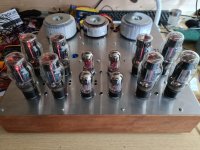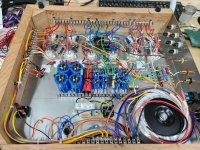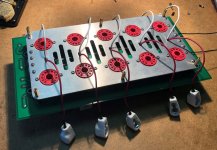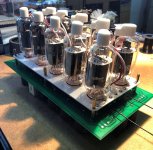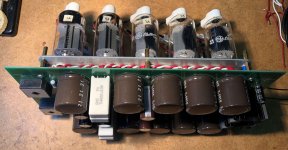1st amp is alive
Well, it all seems to have gone a little quiet on this thread. Not sure if anyone is still interested, but the 1st amp is now alive and pre-conditioning the first set of valves (tubes) as per Ralph's instructions. Will leave this one just with the heaters on for the rest of the week while I finish off Amp No.2, and then connect up the HT and hopefully stick it on the oscilloscope over the weekend to see what we get.
Apologies for the somewhat messy layout on the underside. Have simplified the output stage wiring significantly from the pictures posted a couple of weeks ago. The problem is that as you are working blind on amp 1, you can always see a better way of doing something once it is sat there in front of you. Have already re-wired a fair bit of the circuitry, but at least it will now get me going. As mentioned previously, the chassis used to house a pair of Transcendent Beasts, so have had to do a little swapping and changing and drilling a few more holes to get everything fitting in reasonably well.
Am already thinking that if these work out OK, will probably have a go at building another pair at some stage (swapping over the transformers etc) but building an enclosure more in line with Ralph's commercial amps, to optimise the layout a little better. Final decision will depend on the noise floor. If amps are nice and quiet will probably leave as is.
Cheers,
Steve.
Well, it all seems to have gone a little quiet on this thread. Not sure if anyone is still interested, but the 1st amp is now alive and pre-conditioning the first set of valves (tubes) as per Ralph's instructions. Will leave this one just with the heaters on for the rest of the week while I finish off Amp No.2, and then connect up the HT and hopefully stick it on the oscilloscope over the weekend to see what we get.
Apologies for the somewhat messy layout on the underside. Have simplified the output stage wiring significantly from the pictures posted a couple of weeks ago. The problem is that as you are working blind on amp 1, you can always see a better way of doing something once it is sat there in front of you. Have already re-wired a fair bit of the circuitry, but at least it will now get me going. As mentioned previously, the chassis used to house a pair of Transcendent Beasts, so have had to do a little swapping and changing and drilling a few more holes to get everything fitting in reasonably well.
Am already thinking that if these work out OK, will probably have a go at building another pair at some stage (swapping over the transformers etc) but building an enclosure more in line with Ralph's commercial amps, to optimise the layout a little better. Final decision will depend on the noise floor. If amps are nice and quiet will probably leave as is.
Cheers,
Steve.
Attachments
I don't think the underside looks messy at all. I particularly like the color coding--makes it easy to recognize the topology just from the image. I take it these are monoblocks? I'm also working on a 2-channel circlotron using 21LG6A power tubes (10 per output channel). I got inspiration to start from this thread, and eventually settled on a pentode design instead of triode.
Attachments
W
Apologies for the somewhat messy layout on the underside. Have simplified the output stage wiring significantly from the pictures posted a couple of weeks ago. The problem is that as you are working blind on amp 1, you can always see a better way of doing something once it is sat there in front of you. Have already re-wired a fair bit of the circuitry, but at least it will now get me going. As mentioned previously, the chassis used to house a pair of Transcendent Beasts, so have had to do a little swapping and changing and drilling a few more holes to get everything fitting in reasonably well.
Most of the home builds I've seen have been considerably messier! I think you've done quite well; if it were me I would be using twice as many cable ties and tighten up the wiring around the power transformers (which looks like it isn't complete in your photo...). Keeping the wires between the transformer and rectifiers short is helpful for reducing 'diode noise'.
Thanks Guys,
As you mention Ralph, the wiring isn't yet quite complete with the transformers. All the circuitry is now done and most of the power supply finished, but have just wired up the heater circuits to start with to get the valves preconditioned. Should only take an hour or so to add in the HT leads once that has been done, and will certainly add a few more cable ties as well.
Cheers,
Steve
As you mention Ralph, the wiring isn't yet quite complete with the transformers. All the circuitry is now done and most of the power supply finished, but have just wired up the heater circuits to start with to get the valves preconditioned. Should only take an hour or so to add in the HT leads once that has been done, and will certainly add a few more cable ties as well.
Cheers,
Steve
I don't think the underside looks messy at all. I particularly like the color coding--makes it easy to recognize the topology just from the image. I take it these are monoblocks? I'm also working on a 2-channel circlotron using 21LG6A power tubes (10 per output channel). I got inspiration to start from this thread, and eventually settled on a pentode design instead of triode.
Looks very nice! Could you tell us something about the topology? Schematics would be even nicer ;-)
Looks better than mine! I used 10 power tubes but is very similar to yours. They've seen
pretty much daily duty for around three years. Very stable. I have mine mated to Speltz Zero Autoformers and Super Heresies. Good to hear from you Ralph, thanks again for all the contributions and making it possible.
Mark
pretty much daily duty for around three years. Very stable. I have mine mated to Speltz Zero Autoformers and Super Heresies. Good to hear from you Ralph, thanks again for all the contributions and making it possible.
Mark
Look on page three of this thread.Looks very nice! Could you tell us something about the topology? Schematics would be even nicer ;-)
I was talking about the Pentode design with 21LG6A power tubes that Jerdy described. I have used your Schematic almost directly in my 6C33 version..Look on page three of this thread.
Thanks!
I was talking about the Pentode design with 21LG6A power tubes that Jerdy described.
Thanks!
Appreciate the interest. It's a circlotron topology based off of Alan Kimmel's EL509 design from Vacuum Tube Valley magazine 08. I've been trying to document the build and get community feedback/criticism here: 100 Watt sweep tube Circlotron OTL (WIP)
Well, it all seems to have gone a little quiet on this thread. Not sure if anyone is still interested, but the 1st amp is now alive...
Cheers,
Steve.
Hi Steve. Nice work! I would like to enquire about the transformers. Four? I take it two are for the heater supply.(?) What transformer did you end up using for the high voltage supply. I'm having trouble finding something suitable.
Cheers; Glenn
Hi Dot
The High voltage transformer is the one on the inside of the chassis and is the Antek unit specified in mullardel34's schematics that he did early on in this thread, based on Ralph's original and the tweaks that were discussed in the various posts. Ended up buying it direct from Antek.
On the top of the chassis the centre transformer is for the heaters, and the two outside ones are for the main output HT. I used a transformer with 12V secondaries, so have heaters wired in pairs. Couldn't find a suitable high VA rated 6V unit. The output stages have twin 50V secondaries again wired in series for the 100VAC.
Considering the Antek unit is only rated at 200VA it is huge compared to the others. The output stage ones are 300VA, but somewhat smaller. I originally looked at getting some custom wound, and was talking to a transformer manufacturer here in the UK, but due to current production backlogs they declined to quote. So the output HT ones were sourced from RS Components and the heater one was a Triad Magnetics unit from Mouser
Cheers
Steve.
The High voltage transformer is the one on the inside of the chassis and is the Antek unit specified in mullardel34's schematics that he did early on in this thread, based on Ralph's original and the tweaks that were discussed in the various posts. Ended up buying it direct from Antek.
On the top of the chassis the centre transformer is for the heaters, and the two outside ones are for the main output HT. I used a transformer with 12V secondaries, so have heaters wired in pairs. Couldn't find a suitable high VA rated 6V unit. The output stages have twin 50V secondaries again wired in series for the 100VAC.
Considering the Antek unit is only rated at 200VA it is huge compared to the others. The output stage ones are 300VA, but somewhat smaller. I originally looked at getting some custom wound, and was talking to a transformer manufacturer here in the UK, but due to current production backlogs they declined to quote. So the output HT ones were sourced from RS Components and the heater one was a Triad Magnetics unit from Mouser
Cheers
Steve.
Appreciate the interest. It's a circlotron topology based off of Alan Kimmel's EL509 design from Vacuum Tube Valley magazine 08. I've been trying to document the build and get community feedback/criticism here: 100 Watt sweep tube Circlotron OTL (WIP)
I had a feeling that it was that design. I have always wondered how good it was compared to the zero (or almost zero) feedback Atmasphere triode circlotron.
I was scared away from Kimmel´s designe because of the complexity. I can´t wait to hear your results. Why do you use 21LG6A instead of EL509 (6KG6), EL519 (6P45C) or the equivalent PL versions for series connected heater?
Suitable pre-amps
Hi All,
With the end of the build in sight, can I ask what pre-amps people are using with their M-60's.
As I have been running the Transcendent Beasts for some years, I initially used the grounded grid pre-amp, (built from a kit) and then scratch built Rozenblit's Masterpiece pre-amp after I came across the schematic for it which had been leaked onto the web.
I will, of course start with the Masterpiece, but would be interested to know if anyone else has used this combination and what they thought of it. I also have at home a (currently unpopulated) chinese clone pcb for the CAT SL1 (What looks very much like an accurate full version) and have also previously built the Lite Audio LS26 chinese cheapy version which worked suprisingly well, once a few errors in the schematic were rectified. So the SL1 will also be built up at some stage and I will be interested to see how that works with the M-60's. Happy to look at other pre-amps, but budget will be limited so realistically it will be a home built unit so I can re-cycle parts such as transformers and cases where possible from previous projects. I'd love to try an MP-3 but again that is beyond my current budget.
Any thoughts / comments / suggestions gratefully received.
Cheers
Steve.
Hi All,
With the end of the build in sight, can I ask what pre-amps people are using with their M-60's.
As I have been running the Transcendent Beasts for some years, I initially used the grounded grid pre-amp, (built from a kit) and then scratch built Rozenblit's Masterpiece pre-amp after I came across the schematic for it which had been leaked onto the web.
I will, of course start with the Masterpiece, but would be interested to know if anyone else has used this combination and what they thought of it. I also have at home a (currently unpopulated) chinese clone pcb for the CAT SL1 (What looks very much like an accurate full version) and have also previously built the Lite Audio LS26 chinese cheapy version which worked suprisingly well, once a few errors in the schematic were rectified. So the SL1 will also be built up at some stage and I will be interested to see how that works with the M-60's. Happy to look at other pre-amps, but budget will be limited so realistically it will be a home built unit so I can re-cycle parts such as transformers and cases where possible from previous projects. I'd love to try an MP-3 but again that is beyond my current budget.
Any thoughts / comments / suggestions gratefully received.
Cheers
Steve.
Last edited:
Well... The M-60 is a fully differential design. So a a balanced preamp can be nice... Of course, we make balanced preamps that employ a Circlotron direct-coupled output. I'm of the opinion that using a direct-coupled output at the preamp level may be more important than with the amp, since if the preamp can't get it right you won't be able to correct for that downstream.Hi All,
With the end of the build in sight, can I ask what pre-amps people are using with their M-60's.
I had a feeling that it was that design. I have always wondered how good it was compared to the zero (or almost zero) feedback Atmasphere triode circlotron.
I was scared away from Kimmel´s designe because of the complexity. I can´t wait to hear your results. Why do you use 21LG6A instead of EL509 (6KG6), EL519 (6P45C) or the equivalent PL versions for series connected heater?
I was initially attracted to Kimmel's design because of his use of sweep tubes and the pentode-mode circlotron output. I've made prototypes of the typical triode circlotron, which is far simpler; but I wanted the extra challenge of running them pentode and squeezing as much max current out of them as I could. And I'm finding quite a challenge indeed, since this is easily the most ambitious project I've tried to integrate. I've not seen much reference anywhere to Kimmel's design outside of mere mention, so I'm hoping I can bring something useful to this space.
I looked at the price of the EL509 and then multiplied it by x20... and it was outside of my budget as a college student
Well... The M-60 is a fully differential design. So a a balanced preamp can be nice... Of course, we make balanced preamps that employ a Circlotron direct-coupled output. I'm of the opinion that using a direct-coupled output at the preamp level may be more important than with the amp, since if the preamp can't get it right you won't be able to correct for that downstream.
Hi Ralph,
Yep would love to partner the amps with an MP-3 but out of my budget at the moment . . . . Unless, of course you happen to have a few earlier version bare pcb's lying around that you would be prepared to sell with the schematics
Cheers,
Steve.
@Jerdy What plate voltage are you running on the power tubes?
@valvemaniacuk The tricky bit is actually the power transformers used in the Circlotron. You can get electrostatic noise introduced into the output of the circuit if you aren't careful!
The circuit is very similar to the M-60 but uses a straight differential amplifier driving the grids of the output tube which is a 6SN7 rather than a power tube. Because its easier to drive no driver tube is needed. We usually run the Circlotron supplies at about 120V at their outputs. A servo is used to detect DC Offset at the output XLRs. One of the grids of the 6SN7 is tied thru a 1M resistor to a simple divider network so that the tube is biased at about -1.7V. The output of the servo ties to the other grid thru another 1M resistor and there is a bit of capacitance at the point where that ties to the divider network or output of the servo, to prevent modulation of the network by actual audio.
This is probably a topic for another thread. But this circuit is arguably as transparent as you'll ever get using tubes, with extreme bandwidth too. The main advantage is that no enormous output coupling cap; instead the Circlotron acts as a buffer so the actual coupling caps can be much smaller. The smaller you make the cap the less inductance and other problems it has so it can be more neutral.
@valvemaniacuk The tricky bit is actually the power transformers used in the Circlotron. You can get electrostatic noise introduced into the output of the circuit if you aren't careful!
The circuit is very similar to the M-60 but uses a straight differential amplifier driving the grids of the output tube which is a 6SN7 rather than a power tube. Because its easier to drive no driver tube is needed. We usually run the Circlotron supplies at about 120V at their outputs. A servo is used to detect DC Offset at the output XLRs. One of the grids of the 6SN7 is tied thru a 1M resistor to a simple divider network so that the tube is biased at about -1.7V. The output of the servo ties to the other grid thru another 1M resistor and there is a bit of capacitance at the point where that ties to the divider network or output of the servo, to prevent modulation of the network by actual audio.
This is probably a topic for another thread. But this circuit is arguably as transparent as you'll ever get using tubes, with extreme bandwidth too. The main advantage is that no enormous output coupling cap; instead the Circlotron acts as a buffer so the actual coupling caps can be much smaller. The smaller you make the cap the less inductance and other problems it has so it can be more neutral.
Last edited:
Thanks Ralph,
I appreciate the input and comments. Unfortunately my circuit design skills lag some-what behind my soldering skills, so will take a little while to digest and start to have a play with a few ideas, but you have certainly dangled the carrot. I agree that this should be in a new thread, so may start one up at some stage once I have the M-60's up and running. If anyone else feels like taking up the baton however, then don't let me stop you.
I would also like to add my sincere thanks for all your input into this thread and your willingness to share your concepts, ideas and considerable experience.
Cheers,
Steve.
I appreciate the input and comments. Unfortunately my circuit design skills lag some-what behind my soldering skills, so will take a little while to digest and start to have a play with a few ideas, but you have certainly dangled the carrot. I agree that this should be in a new thread, so may start one up at some stage once I have the M-60's up and running. If anyone else feels like taking up the baton however, then don't let me stop you.
I would also like to add my sincere thanks for all your input into this thread and your willingness to share your concepts, ideas and considerable experience.
Cheers,
Steve.
@Jerdy What plate voltage are you running on the power tubes?
I am using a 500VA isolation transformer with dual 120VAC secondaries, which hovers around 140-150V rectified under load for the anodes. The screens are supplied with 200V, voltage doubled off the floating supply.
- Home
- Amplifiers
- Tubes / Valves
- What tubes for a OTL tube amp?
